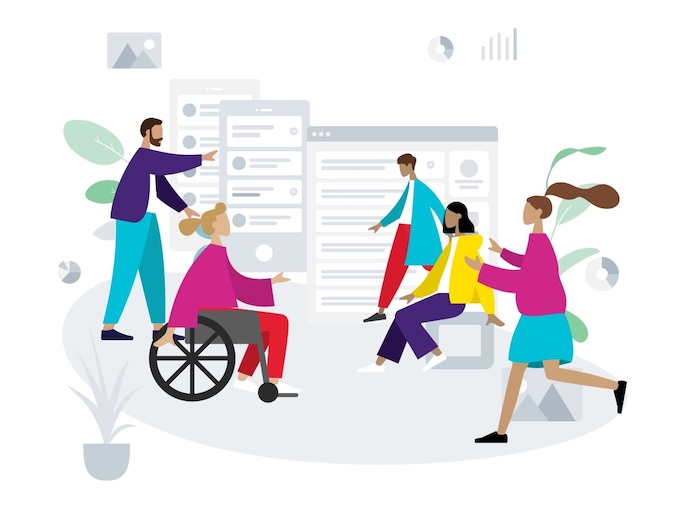Digital service design is a way of thinking, a description of the process, and a set of tools that can be applied to create a user experience that makes the user smile. In the example of any healthcare software creation company, you will see that this desired smile of the client can be caused by sites of all niches.
I have some favorite brands that warm my heart more than others. When I think about what connects these heartstrings, the answer is good design. A brand is easy and pleasant to interact with, whether it’s a product or service, a brand’s social media, a brick-and-mortar store, or an online service.
A successful brand is the sum of many carefully planned elements, and the online service is not a secondary element in this process – quite the opposite. Particularly in industries where business is online, online service is at the forefront of the customer experience.
Designing a good customer experience is not magic, although it does take time and thought. Or if it does, digital service design is the magic wand (backbone) with which to do it. Even with this method, an engaging customer experience cannot be created with a wave of the wand and a flick of the wrist but requires good tools and the right methods.
Table of Contents
So what is digital service design? UX? CX?
A few terms to start with
Service Design could be a user-centered plan of reasoning and at the same time a set of instruments and strategies for planning user-centered and user-centric administrations. Since benefit originators (myself included) cherish characterizing and crystallizing, the field has created its possess lexicon and a heap of distinctive apparatuses for thinking. Let’s take a fast see at a number of them.
Let’s take a quick look at a few.
User-centricity and orientation (also customer-centricity and orientation)
User-centered design starts with, well, the user. Richard Scarry’s book, familiar from childhood, was to the point: What do people do? The user-centered design emphasizes identifying user needs and putting them at the heart of design. User-centered design, on the other hand, involves the user in the design process – letting people tell you what they do.
Customer insight
Customer insight is an understanding of what customers require, how they live their daily lives, and what their aspirations are. Customers’ lives can be studied using both qualitative (interviews, observation, participation…) and quantitative (analytical data, surveys…) methods. Customer insight helps to design more customer-centered services and improve the customer experience.
User Experience (UX) and Customer Experience (CX)
User experience is the feeling you get once you utilize a benefit. It is the discernment, feelings, contemplation, and reactions that emerge from employing a benefit. The client encounter, on the other hand, covers all client experiences with the company. Even on the off chance that, in case, the client encounters an internet shop that is cleaned down to the final component, the client involvement begins to suffer if the conveyance of packages is deferred.
Customer journey map
A benefit travel map could be a visual representation of how a client interacts with a company in several circumstances when employing a benefit. It could be a device for depicting an intangible benefit that’s made up of numerous stages in an unmistakable entirety. And particularly from the customer’s point of view. It is especially valuable to get the current state of the benefit.
- For example, our client may see our advertisement while browsing LinkedIn, later search our company on search engines, and, after doing some background research, decide to email our services requesting a quote for the design and definition of an online service, and so on. The customer journey takes many channels and interacts with the Inoxoft brand in different ways.
Service concept
A clearly documented, holistic description of the service is planned. Answers the questions: for whom, why, how, and with what resources? Often the service concept is one of the outcomes of service design.
- Inoxoft frequently refers to the final output of our service design projects as a specification document, because Inoxoft usually also goes into detail about how to build the conceptualized service.
Design thinking
It is difficult to talk about service design without mentioning design thinking. It is a process that focuses on understanding the user in-depth and shaking up preconceptions. Furthermore, it is both a process and a holistic way of working, the beauty of which lies in the fact that it takes design beyond the design team itself. By combining analytical and creative thinking, it is possible to design services for your clients.
- At Inoxoft we typically implement “hybrid solutions” where we use both traditional page bases and modular pages. In each project, based on the goals, users, and content of the site, which page templates and modules will be designed and implemented to make the site best serve its purpose?
- The most common page-based content is, for example, articles and quantitative pages such as links, search result pages, article listing pages, and other lists. The main pages, landing pages, and presentation pages of the service work as an implementation of the module.
- It is also possible to use modules at the end of fixed landing pages – for example, at the end of an article, it may be appropriate to move the content samples selected by the administrator or a CTA button as a module block to guide the user forward on the site. In the case of frequently updated or published content, you should especially consider using a page template that simplifies content entry and management.
It is important for us to consider the structure of the site and the number of modules according to the volume of the client’s content, as well as taking into account the resources for content input and support. If the site is maintained by the only communicator of the company, who tries to do his job efficiently, it is not worth messing around with the site, just to save time. On the other hand, if it is a larger organization where resources can be found more quickly, the modules can be very fine-tuned, for example in terms of colors and skills. One great example of such an organization is our client plan, which can be seen in the picture above.







… [Trackback]
[…] Read More Info here to that Topic: news969.com/good-design-is-more-than-just-a-beautiful-look-this-is-why-i-love-digital-service-design/ […]
… [Trackback]
[…] Find More here on that Topic: news969.com/good-design-is-more-than-just-a-beautiful-look-this-is-why-i-love-digital-service-design/ […]
… [Trackback]
[…] Here you will find 88010 more Information to that Topic: news969.com/good-design-is-more-than-just-a-beautiful-look-this-is-why-i-love-digital-service-design/ […]
… [Trackback]
[…] Read More Info here on that Topic: news969.com/good-design-is-more-than-just-a-beautiful-look-this-is-why-i-love-digital-service-design/ […]